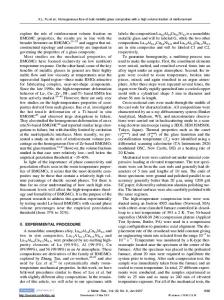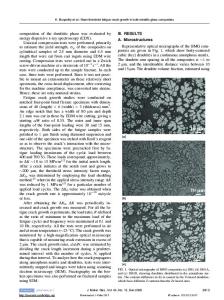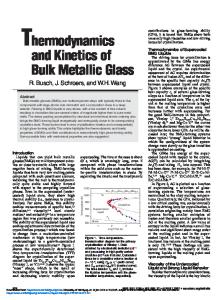Synchrotron X-ray Diffraction Measurement of Reinforcement Strains in Uniaxially Stressed Bulk Metallic Glass Composites
- PDF / 152,253 Bytes
- 6 Pages / 612 x 792 pts (letter) Page_size
- 49 Downloads / 301 Views
Synchrotron X-ray Diffraction Measurement of Reinforcement Strains in Uniaxially Stressed Bulk Metallic Glass Composites Dorian K. Balch, Ersan Üstündag1, and David C. Dunand Department of Materials Science and Engineering, Northwestern University, Evanston, IL 60208 Department of Materials Science, California Institute of Technology, Pasadena, CA 91125
(1)
ABSTRACT High-energy synchrotron x-rays were used to measure internal reinforcement strains in bulk metallic glass composites containing tungsten or tantalum particles during in-situ uniaxial tensile loading. Load transfer from the matrix to the stiffer but weaker particles was characterized in both their elastic and plastic regimes and compared to theoretical predictions. INTRODUCTION Bulk metallic glasses (BMGs) are multi-component alloys capable of retaining an amorphous structure upon quenching at low to moderate cooling rates (1 to 100 K/s). Bulk metallic glasses generally have an attractive combination of properties: very high strength (close to 2 GPa), high fracture toughness (40 – 55 MPa⋅m1/2), excellent wear and corrosion resistance, and a very high elastic limit (~ 2%). [1] They also have the tendency to fail catastrophically when unconstrained by shear banding after very limited plastic deformation. Composites of BMGs exhibit increased strength and ductility as compared to the BMG matrix, by a combination of load transfer to stiffer second phases and arresting of shear bands by the second phases. Bulk metallic glasses reinforced with metallic fibers or particulates can exhibit plastic strains up to 10% while maintaining very high strengths. [2,3] As BMGs generally have relatively low Young’s moduli (~ 80 – 105 GPa), load transfer to stiffer second phase reinforcements during loading is significant. Furthermore, as plasticity occurs in the reinforcement but not in the matrix, load transfer is expected to vary upon loading. The evolution of the partitioning of applied load can be investigated by in-situ x-ray diffraction measurements at synchrotron x-ray facilities, where the availability of high-energy, highintensity x-rays allows for the type of bulk measurements previously performed by neutron diffraction with the added advantage that relatively small samples can be studied. EXPERIMENTAL Three BMG composites were cast in a copper mold after the BMG alloy and the reinforcement powders were mixed in a silver boat, as described in Reference 4. The matrix material was Vitreloy 106, with a nominal composition of Zr57Nb5Al10Cu15.4Ni12.6. This matrix was reinforced with tungsten or tantalum particles with nominal diameters of ~ 15 µm and nominal volume fractions of 5 and 10% for tungsten and 5% for tantalum. Characterization of the particle sizes and volume fractions was performed by scanning electron microscopy. Dog-bone shaped tensile specimens were machined with gauge sections approximately 10 mm long, 1 mm wide, and 1 mm thick. In-situ uniaxial tensile tests were performed at the Advanced Photon Source, Argonne National Laboratory, using a small screw-
Data Loading...











